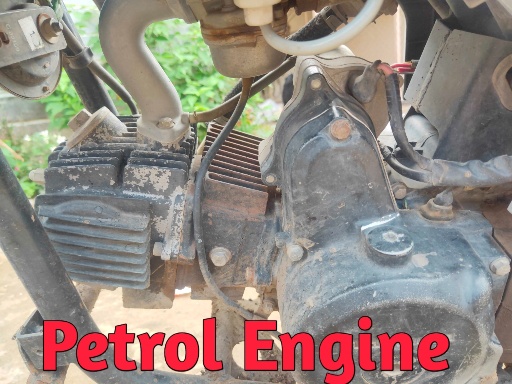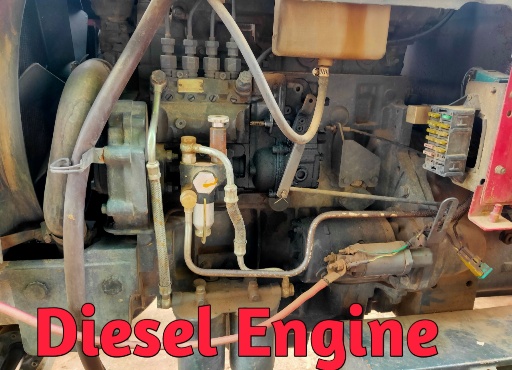The Mechanical engineering, is playing a important role in today's Technology.
It Assist you to done things with ease, so let's learn about petrol engine and diesel engine, that helps to modernize our society.
So keeping these things in mind, Lets learn about the difference between petrol engine and diesel engine.
Let's Brief learn about petrol engine and diesel engine.
Petrol engine:-
 |
| Petrol Engine |
The petrol engine, during the suction stroke it can intake a mixture of petrol and air.
For proper mixing of petrol and air at required proportion the carburettor is used.
At the end of the compression in petrol engine the pressure produced is about to 10 bar.
To ignite charge in petrol engine the spark plug is used.
Combustion engine takes place and constant volume process. So the Petrol engine works on Otto cycle.
The compression ratio of petrol engine is low and the value is varies in between 6 to 10. Due to the low compression ratio the starting of the petrol engine is easy.
Petrol engine is cheap and lighter than diesel engine.
Thermal efficiency of petrol engine is about to 25 to 30%. Petrol engine is easy to start the fuel cost of petrol engine is more. But the maintenance cost of petrol engine is less.
Due to low thermal efficiency in a petrol engine the problem of overheating is more.
Petrol engine is high speed engine.
Generally the the rating of petrol is depend on octane number of petrol. And the number is varies from 80 to 100.
Petrol engine is used in light duty vehicle, such as scooter, motorcycle etc.
Diesel engine:-
 |
| Diesel Engine |
The diesel engine, during the suction stroke the engine can take only air.
The atomizer aur injector is used to inject the fuel at the end of the compression.
A pressure produced in a diesel engine at the end of the compression is 35 bar.
In diesel engine the fuel is injected in the form of fine spray and the temperature of compressed air is highly sufficient to burn the fuel.
The working of diesel engine is on diesel cycle.
The combustion of fuel is take place at constant pressure process.
The diesel engine having high compression ratio and the value of compression ratio is where is between 15 to 25.
So due to high compression ratio the starting of the diesel engine is difficult.
The fuel cost of diesel engine is less compared to petrol engine so the running cost of diesel engine is low.
Diesel engine is heavy and costlier. So Space required for diesel engine is more.
The thermal efficiency of diesel engine is about 35 to 45%.
Due to high thermal efficiency the problem of overheating is less.
The rating of diesel is decided on a cetane number. Generally the cetane number for Diesel is 40 to 55.
Application of diesel engine is for heavy duty vehicle, such as trucks, buses, Earth moving equipments etc.
Difference between petrol Engine and diesel engine.
|
No.
|
Petrol Engine
|
Diesel Engine
|
|
1.
|
During suction Stroke the petrol engine can intake a mixture of petrol and air. | During suction stroke the diesel engine can take intake as only air.
|
|
2.
|
The carburettor is used to mix air and petrol to get a required proportion and supplied to the engine during suction stroke.
|
The atomizer or a injector is used to inject the fuel at the end of the compression stroke.
|
|
3.
|
The pressure produced in petrol engine at the end of compression is about 10 bar.
|
The pressure produced in diesel engine at the end of the compression is about 35 Bar.
|
|
4.
|
In petrol engine the charge that is petrol and air is ignited with the help of spark plug.
|
In Diesel engine the fuel is injected in the form of fine spray and the temperature of compressed air is sufficiently high to ignite the fuel.
|
|
5.
|
Combustion of fuel takes place approximately at constant volume process.
|
The combustion of fuel takes place approximately at constant pressure process.
|
|
6.
|
The petrol engine works on Otto cycle.
|
The diesel engine works on diesel cycle.
|
|
7.
|
Petrol engine having low compression ratio comparatively diesel engine.
|
Diesel engine having high compression ratio comparatively petrol engine.
|
|
8.
|
Value of compression ratio varies in petrol engine from 6 to 10.
|
Value of compression ratio varies is in diesel engine from 15 to 25.
|
|
9.
|
Due to low compression ratio the starting of petrol engine is easy.
|
Due to high compression ratio the starting of diesel engine is difficult.
|
|
10.
|
Petrol engine is lighter and cheap because of low compression ratio.
|
Diesel engine needs heavier and costly because of low compression ratio.
|
|
11.
|
Fuel cost of petrol engine is high compare to diesel engine.
|
Fuel cost of diesel engine is low compared to petrol engine.
|
|
12.
|
The running cost of petrol engine is more because of higher price of petrol.
|
The running cost of diesel engine is less because of lower the price of diesel.
|
|
13.
|
The maintenance cost of petrol engine is lesser.
|
The maintenance cost of diesel engine is more.
|
|
14.
|
The thermal efficiency of petrol engine is nearly about 26%.
|
The thermal efficiency of diesel engine is nearly about 40%.
|
|
15.
|
Due to low thermal efficiency the problem of overeating is more.
|
Due to higher thermal efficiency than petrol engine the problem of overheating is a less.
|
|
16.
|
These are high speed engines.
|
These are relatively low speed engines.
|
|
17.
|
The space required for petrol engine is less.
|
The space required for diesel engine is more.
|
|
18.
|
For rating of petrol engine the octane number is used.
|
For rating of diesel engine the cetane number is used.
|
|
19.
|
Octane number of petrol is generally available are 80 to 100.
|
Cetane number of diesel is generally available are 40 to 55.
|
|
20.
|
The petrol engine are generally used in light duty vehicles.
|
The diesel engine are generally used in heavy duty vehicles.
|
|
21.
|
Examples of petrol engine:- Scooters, motorcycles, cars, light duty vehicles etc.
|
Examples of diesel engine:- Buses, trucks, Earth moving equipments, heavy duty vehicles etc. |
In modern vehicles, components like the automotive PCB play a vital role in managing and optimizing engine performance. These printed circuit boards are essential for integrating electronic control systems in both petrol and diesel engines.
Here we concluding, If you have any queries about this topic of petrol engine and diesel engine then feel free to comment below.
To get more articles please check on www.mechlearning.com
Related articles:








0 comments:
If you have any doubt, please let me know